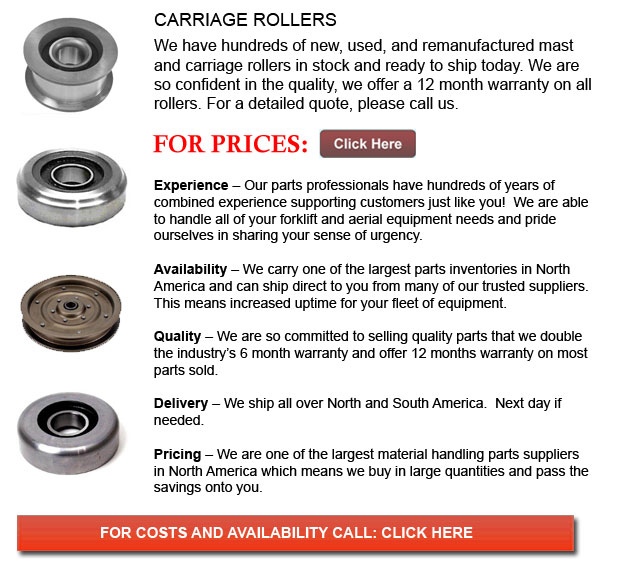Carriage rollers are particularly designed bearings which are utilized on lift masts to be able to help them function within difficult environmental conditions. Lift masts are frequently subjected to oscillations, shocks, vibrations and high dynamic and static loads. This apparatus is frequently exposed to environmental influences such as heat, dust, cold, contamination, aggressive ambient air and moisture. Thus, the guidance arrangements of lift masts must be specifically tough and have a certain high load carrying capability.
Carriage rollers have been developed as the solution for functioning in various environmental conditions. These bearings are the answer where the guidance arrangements of the lift masts need to be economical and maintain operational security while having the ability to deal with a specifically high load carrying capacity.
 Click to Download the pdf
Click to Download the pdf
Forklift Parts
Alternators
An alternator is actually a machine which converts mechanical energy into electric energy. This is done in the form of an electrical current. In essence, an AC electrical generator could be referred to as an alternator. The word normally refers to a small, rotating device driven by automotive and different internal combustion engines. Alternators which are situated in power stations...
More
Brakes
A brake wherein the friction is provided by a set of brake pads or brake shoes which press against a rotating drum unit referred to as a brake drum. There are a few specific differences between brake drum kinds. A "brake drum" is usually the explanation provided if shoes press on the interior exterior of the drum. A "clasp brake"...
More
Carriages and Carriage Parts
Rated by the fork carriage lifting capability, there are actually four sizes of hook type blade carriages. The hook type tine carriages have been standardized.
The carriage bar spacing utilized for Class 1 is approximately thirteen inches and the Class 1 carriage is rated to hold loads as much as 2000lbs. The Class 2 carriage is rated to hold cargo...
More
Control Valves
Automatic control systems were first created more than two thousand years ago. The ancient water clock of Ktesibios in Alexandria Egypt dating to the third century B.C. is believed to be the very first feedback control equipment on record. This particular clock kept time by means of regulating the water level in a vessel and the water flow from the...
More
Controllers
Lift trucks are accessible in different load capacities and several units. Most lift trucks in a regular warehouse situation have load capacities between one to five tons. Bigger scale models are utilized for heavier loads, like loading shipping containers, could have up to 50 tons lift capacity.
The operator could utilize a control to lower and raise the blades, which...
More
Differentials
A mechanical device which can transmit rotation and torque via three shafts is known as a differential. Every now and then but not at all times the differential would utilize gears and will function in two ways: in vehicles, it provides two outputs and receives one input. The other way a differential operates is to combine two inputs in order...
More
Drive Axles
A lift truck drive axle is actually a piece of machinery which is elastically affixed to a vehicle frame with a lift mast. The lift mast is connected to the drive axle and is capable of being inclined round the drive axle's axial centerline. This is accomplished by no less than one tilting cylinder. Forward bearing parts along with back...
More
Drive Motors
MCC's or otherwise known as Motor Control Centersare an assembly of one section or more which have a common power bus. These have been used in the auto trade since the 1950's, as they were utilized a lot of electric motors. Today, they are utilized in a variety of industrial and commercial applications.
Inside factory assembly for motor starter; motor...
More


![]() Click to Download the pdf
Click to Download the pdf











